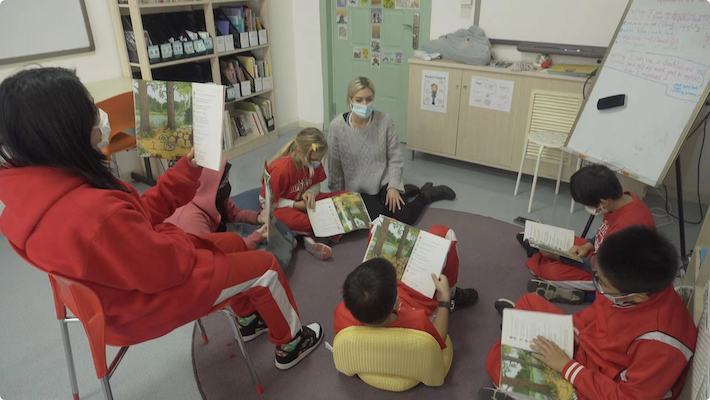Most people would agree that one of the best things about Beijing’s international community is the wide range of cultures and languages you come into contact with. Being part of this community positively impacts our children’s development, helping them to grow into internationally-minded global citizens. However, since international schools in Beijing teach primarily in English, adapting to this new language environment can be a challenge for students from the international community who didn’t grow up in a primarily English-speaking household.
In the distance past, some international schools teaching in English avoided or reduced the use of students’ home languages. However, research has increasingly shown that drawing on students’ home languages and cultural background can help to validate and enforce their personal identities, while also providing a strong foundation for learning other languages.

CISB’s BML program includes one-on-one and small group instruction and co-teaching
This concept is at the core of the Bilingual and Multilingual Learners (BML) program at the Canadian International School of Beijing (CISB). “CISB has had a language support program since the school opened in 2006, but in 2019, our elementary school decided to change the name from English as an additional language to BML. We wanted to change the way we view BML/EAL students from a deficit to a strengths perspective, one that emphasizes competencies and potential, and focuses on resilience and empowerment,” Rose Muralla, BML department head, says. “We also wanted to create an environment that celebrates diversity in language and multilingualism.”
The goal of the BML program is to reach each child’s full language potential by making authentic links to their Homeroom class’s curriculum and providing a differentiated approach for each student. Data from in-class and formal assessments (including WIDA and MAP assessments) are used to determine a student’s needs, and the BML teacher designs targeted instruction in speaking, listening, reading, and writing using leveled texts and materials.
“I had a hard time writing sentences before joining the BML intervention program. Doing the different activities we do every day, now I feel more confident in writing sentences and trying to spell words on my own.” — Martina, grade 2
For example, for new students at CISB, the focus will be on building functional language to ease their transition. This might include building a bank of classroom vocabulary, such as classroom objects, and teaching phrases and sentence stems that will allow them to communicate with teachers and classmates. Sentence stems, in particular, can be useful for bilingual and multilingual learners, since they give children the tools to focus on what they are trying to say rather than how to say it. Grade 5 Chinese student Harry told jingkids that “in BML we can learn many things to use in my homeroom class. We use many materials. For example, we have tiny phones to hear yourself reading in a quiet voice. We also have A to Z blocks to make words.”
Regular BML support might include BML teachers supporting students in small groups or one on one, and co-planning and co-teaching with Homeroom teachers. “Having more than one teacher in the room creates multiple perspectives or ways of teaching a concept and gives another set of eyes for assessment or feedback about students that can contribute to meeting a student’s needs and recognizing gaps,” Rose explains.

Students taking part in CISB’s reading intervention program
This year, the BML Department has also started a reading intervention program where students get extra support from CISB’s interventionists to develop reading, vocabulary, phonics and comprehension skills aside from the support they are regularly getting from the grade level BML teachers. At the end of the six weeks, the BML teacher, the homeroom teacher, and the intervention teacher determine if children need to continue in the intervention program. “BML intervention helped me learn reading strategies like sounding out the words (phonemes and graphemes) so I can read and write words and also to make a picture of what the words mean in my head,” grade 2 student Oskar says.
“I struggled with phonics but now my phonics is good. I like my BML reading because I can find a lot of funny things in the stories.” — Cedrick, grade 5
Beyond simple English language proficiency, CISB’s BML program is about recognizing that although a student might come to CISB needing support in expressing themselves in English, they might already have the background knowledge to understand the concept they are learning in class in their mother tongue. As Rose concludes, “BML at CISB is different because we are not just supporting our BMLs with their English language skills but also empowering them to embrace and celebrate their mother tongue and culture.”
Images courtesy of CISB
Thank you to the whole of the BML department for their invaluable contributions to this article




